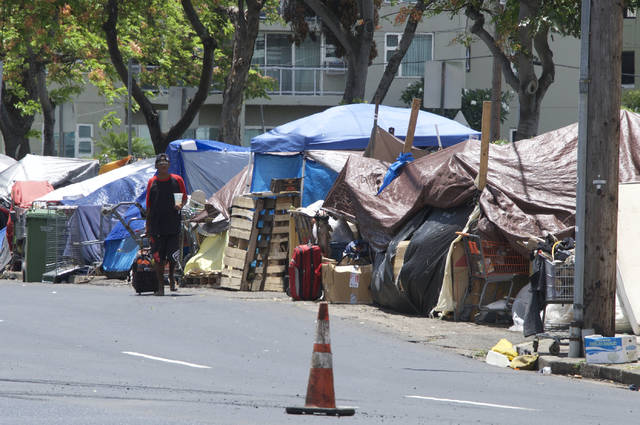More homeless, more creative housing

CRAIG T. KOJIMA / CKOJIMA@STARADVERTISER.COM
Homeless structures line Iwilei Road to King Street.
After being accosted by a homeless woman recently, I decided to do research on our homeless issue and here’s what I learned.
First, I believe the state’s “Point in Time” counts are inaccurate. A 1993 “Hawaii Investor” magazine cover story stated our homeless population was almost 8,000 then; in 2016, the count was 7,921; and in 2017, it is now 7,220.
Scott Morishige, our state’s homeless coordinator, stated that we placed 2,000 people in housing in 2015, and another 3,000 in 2016. So the actual number of homeless before the government stepped in was approximately 12,220. This tracks with my statistical counting dating back to 1993, which would put our statewide homeless population up to 13,500.
As I continue to watch the new bodies coming through my neighborhood of Waikiki, I would believe my counts are more believable and I think many would agree there has been an exponential increase of people living on the streets for the past 24 years.
Don't miss out on what's happening!
Stay in touch with breaking news, as it happens, conveniently in your email inbox. It's FREE!
Second, unfortunately, this condition is now financially consuming us. We are spending millions of dollars yearly to assist these people, most of who will never contribute to our tax base.
And while we know homelessness can be attributed to five major issues — lack of education and of jobs, drug use, cost of living, and lack of affordable housing — there is now a new crisis looming. It is the baby boomers who are retiring without any means to support themselves.
Kimo Carvalho of the Institute for Human Services has stated the largest-growing segment of homelessness is now the elderly.
A 2014 U.S. Federal Reserve report showed 70 percent of all retirees have less then $1,000 in savings, and 58 percent have less then $10,000 in retirement funds and rely on Social Security to take them through their final years. Sadly, with the costs of living and housing increasing, more seniors are finding they cannot eat and keep renting and are ending up houseless. Many are alone or their families cannot help them.
So what do we do to resolve this current condition?
Foremost, we all have to agree we are one community and in this crisis together. It is not acceptable to allow people to live in squalor under bridges, in parks, streets and mountains, and say to ourselves “as long as they are not in my back yard and don’t bother me, let them live their lives.” We cannot legitimize their living arrangements by publishing maps of their camps. We cannot allow illegal camping on public properties and using open spaces as toilets.
We need to find new ways to build temporary housing.
Government needs to open up industrial spaces for residential use or allow owners to convert warehouses into housing units. Maybe allow Quonset huts again, which were once staple housing. What about manufactured or prefab units or mobile home parks?
Permanent housing can be built later when the money is found, but this temporary housing will immediately get people off the streets.
We must act now because if my statistical analysis is correct, and significant action is not taken to provide for housing, then in 10 years there could be a homeless population in the 35,000 to 40,000 ranges living on our streets. This would be like a cancer consuming our very existence, destroying our businesses and the fabric of our lives.
As a keiki o ka aina, I was raised to always be a part of the community and assist when needed. It is now the time to help our less fortunate people and our aina. Will you stand with me so we can create a better future?
Stephany Sofos is a real estate broker, appraiser and author of “Untold Stories of a Real Estate Diva.”



